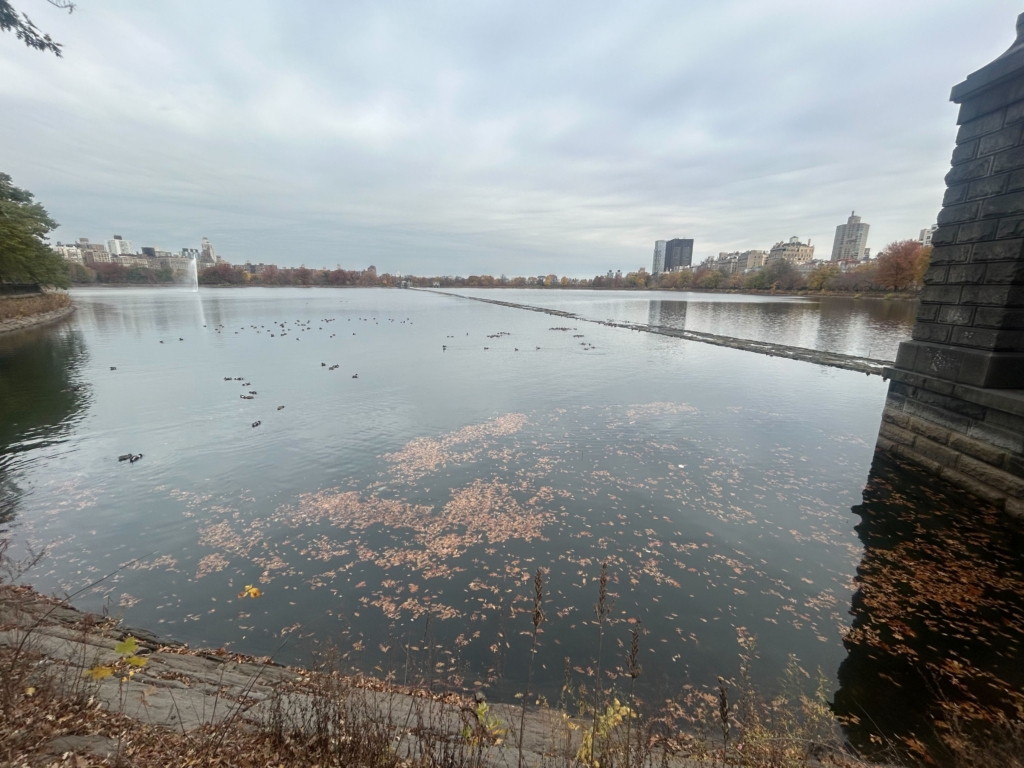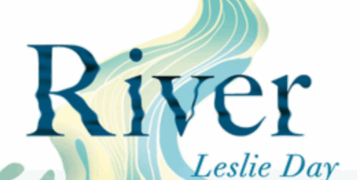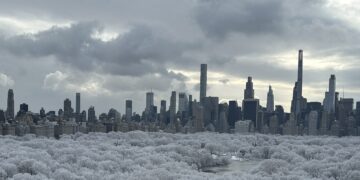
By Gus Saltonstall
The ongoing drought conditions are having a variety of effects on New York City.
This includes an unexpected development in the Jacqueline Kennedy Onassis Reservoir within Central Park.
The Reservoir, located between West 86th and 96th streets in the park, has seen its water levels diminish to the point that a divider wall, typically hidden below the surface, is now visible above the water. Multiple locals on Upper West Side Facebook groups mentioned that it was the first time they had ever seen the structure.
Here’s a bird’s-eye view of it.

The Central Park Reservoir has not provided water to New Yorkers since 1993, due to concerns at the time about contamination from algae. It was renamed the Jacqueline Kennedy Onassis Reservoir in 1994 to honor the former First Lady, who enjoyed jogging around it.
If it were used in 2024, the Central Park Reservoir would only supply New Yorkers with enough fresh water for about one day, according to the Central Park Conservancy.
Still, the Reservoir holds more than one billion gallons of water, spanning 106 acres, while reaching depths of 40 feet. It is filled by water from upstate aqueducts, which, as previously reported, are below their typical threshold due to a drought caused by the lack of rain.
These lower water levels are now having an effect on the Reservoir.
Rain is forecast for Wednesday and Thursday, so we’ll see how much that helps.
Subscribe to West Side Rag’s FREE email newsletter here. And you can Support the Rag here.









For anyone else who is curious about why it’s divided in half… Apparently the wall separates the res into halves so that (when the reservoir was in use) one side could be drained at a time for work.
Nice photo, though!
I have seen this dividing bridge exposed on many occasions over the years, not just during a drought-like moment that we are experiencing now. Not sure what is going on here.
One thing that is happening is the ducks and other waterfowl which winter in the reservoir now have a dry place to roost. The steeply sloped banks of the reservoir are poor for this purpose. Meaning this could be done on purpose. It should be if it isn’t.
I have often seen a long line of birds resting on this divider, even when it was covered with water. I wondered what they were doing — now I know 🙂
What is the purpose of the divider wall?
From Wikipedia Jacqueline Kennedy Onassis Reservoir : The north and south gatehouses are connected by a visible causeway bisecting the reservoir, which is actually the top of a wall that splits the reservoir into two chambers. The bifurcation was intended to allow one half to be drained for maintenance while the other half continued to function. As originally designed, the north gatehouse pumped water into the reservoir while the south gatehouse pumped water out, so as to supply water to lower Manhattan. The gatehouses were decommissioned in 1993 but remain in place today.
It’s good for the birds, they have a new place to rest
DEP used to do tours where you could go through one of the gatehouses and walk out on that wall.
If it doesn’t supply water, why is it still existing. That’s a lot of park real estate that could be used for myriad things.
The dividing wall becomes visible EVERY WINTER. This has been true for at least the 74 years that I’ve been birding there. Since this is an annual occurrence I was always under the impression that the water was deliberately lowered during the winter.
Back in the 60’s, before she married Onassis, Jackie lived in a high rise on 5th Avenue across from Central Park. My high school was a block away and I was on the track team. After class we would practice on the path running around the reservoir, and several times a week we would see Jackie jogging along near us. Following a discreet distance behind her, on a bicycle and wearing a suit and tie, was her Secret Service protection.
First, greatly like the Carol Tannenhauser photograph! Second, the appearance of this structure is not so unusual.
If you look closely often you’ll see ducks / birds on the wall, even if there’s some water above it. You don’t see the wall but you’ll see the animals create a line, which is a funny sight!
stop feeding birds inside the reservoir. In addition, stop throwing empty bottles, your snack wraps, napkins, bottle tops, any garbage that you or your children carry into the water. There are designated garbage cans all over the park and at the entrances to the reservoir.